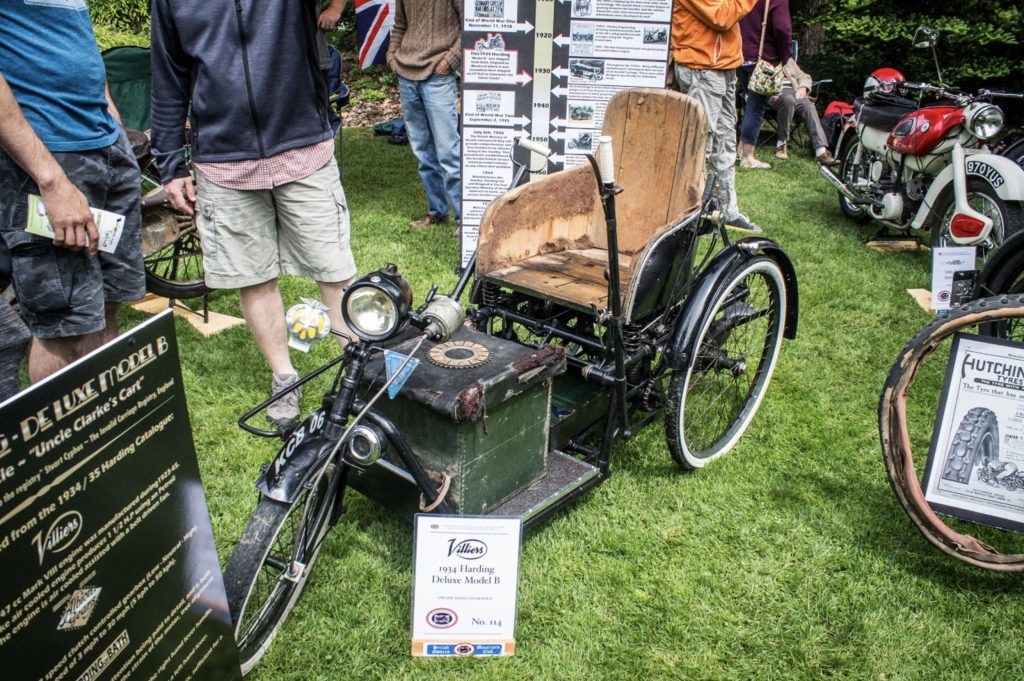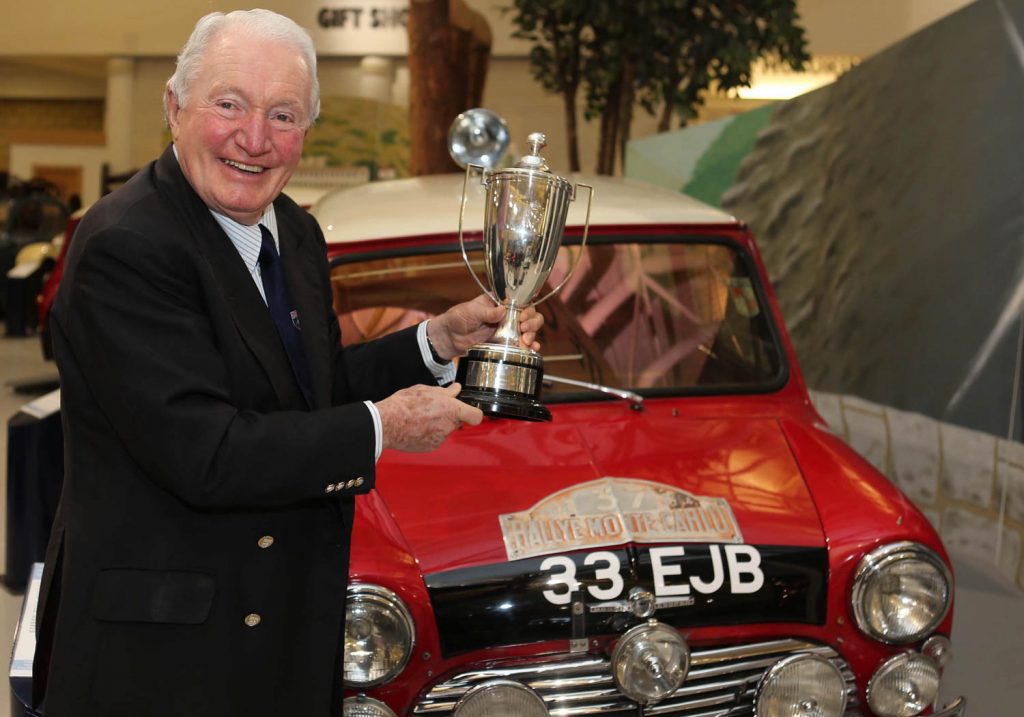This story first appeared in 2019, on the 55th anniversary of Hopkirk’s historic victory. He passed away in July 2022, but we wanted to update it to mark the 60th anniversary, because it remains no less monumental today as it did then.—ED
No one expected him to win.
Not the competition, not the race officials, and not even the driver himself. Yet 60 years ago, Patrick “Paddy” Hopkirk and his co-driver, Henry Liddon, came out ahead in one of the greatest David versus Goliath motorsports battles ever. Pitched against factory teams from Mercedes-Benz, Saab, Volvo, Citroën, and Ford, with its onslaught of eight V8-powered Falcons, Hopkirk’s bright red Mini Cooper S emerged victorious as the winner of the 1964 Monte Carlo rally.
Overnight, Paddy Hopkirk became a household name, and the Mini cemented a lasting reputation for punching well above its weight. This year being the 60th [now 65th] anniversary of the Mini, we caught up with Paddy at his Buckinghamshire home to talk about his greatest race.
“At the time, I didn’t realize how important it was going to be,” he says. “It was just another rally win to me.”

In the winter of 1963, Hopkirk wasn’t famous, but well-known in rallying circles. He’d cut his teeth on motorized contraptions early, flogging a highly unstable, inherited 250cc invalid carriage around an estate near his Belfast home as a child, and then moving into autotest handling competitions in his university days. Success came early, rallying VW Beetles and later Triumphs around the narrow lanes of the Irish countryside.
Hopkirk was initially unimpressed by the Mini. “I saw it coming into the local showrooms,” he says. “At the time, we sort of laughed at it. We called it the district nurse’s car. My [BMC] team manager Stuart Turner convinced me to have a go in a Cooper [at Oulton Park Circuit] and I remember being absolutely knocked over by it. The performance, the handling – it was love at first drive.”

What was to become the most famous Cooper in the world, registration number 33 EJB, was successfully campaigned by Hopkirk at the 1963 Tour de France. He beat out the 3.8-liter Jaguar Mk IIs in the Touring division, finished first in his class, and when the handicaps were worked out, ended up besting a Ferrari 250 GTO driven by Jean Guichet, later winner of the 24 Hours of Le Mans, in 1964.
The three months prior to the 1964 rally required painstaking reconnaissance of the mountain passes around Monte Carlo. Preparation was a grind, but a shared task. “Rallying’s not like an Olympic sport,” says Hopkirk. “It’s a team effort. I had a wonderful team coordinator, wonderful mechanics, the right team.”

Unlike modern stage rally, the Monte Carlo rally didn’t start from a single location, but required first driving long distance from one of nine European cities to a gathering point to begin the timed sections. BMC racing manager Turner hedged his bets by dividing up his teams to improve the odds. Crews were sent to far-flung places like Glasgow and Athens. In the case of Hopkirk, Liddon, and 33 EJB, the spot was Minsk in Russia – behind the Iron Curtain.
“I, like an idiot, put my hand up, because I’d never been [to the Soviet Union],” Hopkirk says.
Having a sense of adventure was key to the rallying spirit in those days, as was an entrepreneurial bent. Hopkirk took along a supply of nylon stockings and bartered them for a huge tin of Number One beluga caviar, which he stashed among the spare parts in his Cooper, hoping to sell it for a profit when they arrived in Monte Carlo. Just getting to the gathering point in Reims, France, was a difficult task.
“We had to press on because you never knew what was around the corner,” Hopkirk explains. “We didn’t go flat out, but you had to build up time. You’d be driving along and hear a mechanical noise, and just hope that the mechanics could fix it when you caught up to them. But you weren’t always sure where they were going to be. There was very little communication.”
To stave off weariness, Hopkirk and Liddon relied on Dexedrine and coffee. Liddon operated the roof-mounted light to shine around corners while Hopkirk tried to make time on unfamiliar roads in darkness. At last, they arrived in Reims, and the rally began in earnest. It almost immediately ended in disaster.

On the first day, the team was stopped by a gendarme for accidentally turning the wrong direction up a one-way road. Hopkirk flipped on the charm and claimed he had given up the rally and was only heading home because his mother had died. If arrested, the team would have been instantly disqualified. They got away with it, turned the corner, and went flat out to make up for lost time.
“Nobody knew what was happening,” he says of the special stages. “When you started, one set of officials would mark down the time, and another set would record when you arrived on the other side of the mountain. The results were sent on ahead, but until it was all calculated, no one knew how they were doing. As we were heading into Monte Carlo, Stuart Turner asked us, ‘How’ve you done, lads?’ and we replied, ‘We don’t know, but we haven’t hit anything.’”
Icy conditions and narrow roads, however, proved a considerable advantage for the small, front-drive Mini. “The French plows made a hard bank, and if the Mini got sideways it didn’t hit, not like the larger cars. Front-wheel drive was fast and safe on the downhills.”
Overall, Ford’s Falcon team was quicker on nearly every stage except those on the narrowest roads. However, their 289-cubic-inch V8s were more than four times the size of the 1071cc engine in the Cooper. Hopkirk was quick behind the wheel and mechanically sympathetic to the little Mini. “Left-foot braking is a bit overrated,” he says. “Fast, but you break the car.”

Finally, after four days and nights, they all arrived in Monte Carlo for a well-deserved break. Hopkirk remembers getting a call from French journalist Bernard Cahier at four o’clock in the morning, telling him that the Mini team might have won the whole rally. Hopkirk didn’t believe him.
But the next morning, the results were up on the board, and Hopkirk and Liddon were in the lead. There was just one final stage to go: five laps of the F1 circuit around Monaco.
“I felt a bit of pressure,” Hopkirk says. “But we had enough of a lead that I didn’t have to drive too fast. I just didn’t want to make any stupid mistakes and break the car.”
On the Monaco circuit, Swede Bosse Ljungfeldt was finally able to use the full V8 power of his Ford Falcon and was about 30 seconds faster around the course than Hopkirk’s Cooper. Even so, when the dust settled, the Mini had accumulated 2152.1 penalty points to the Ford’s 2216.2.

“I have a photo of [Mini designer] Alec Issigonis and [F1 champion] Fangio and me drinking champagne and eating the caviar out of that tin on the balcony of the Hotel Paris,” Hopkirk laughs. “I never got paid for it.”
The victory made headlines around the world, with LIFE magazine dispatching a reporter to cover the story, and congratulatory notes from the British and Northern Irish Prime Ministers. At the height of Beatlemania, Hopkirk even got fan mail from the Fab Four.
All these years later, Hopkirk is humble about the win, noting that the effort was as much about mechanics lying under cars in cold ditches as it was about the driving. “I was lucky to be in the right place at the right time,” he says.
A bit of luck, some cheeky daring, and the skill to go flat out when it really matters. No one saw Paddy Hopkirk and his Mini Cooper coming 60 years ago, but they slayed the giants and became legends.










And they repeated it three more times but apparently the third time didn’t count.